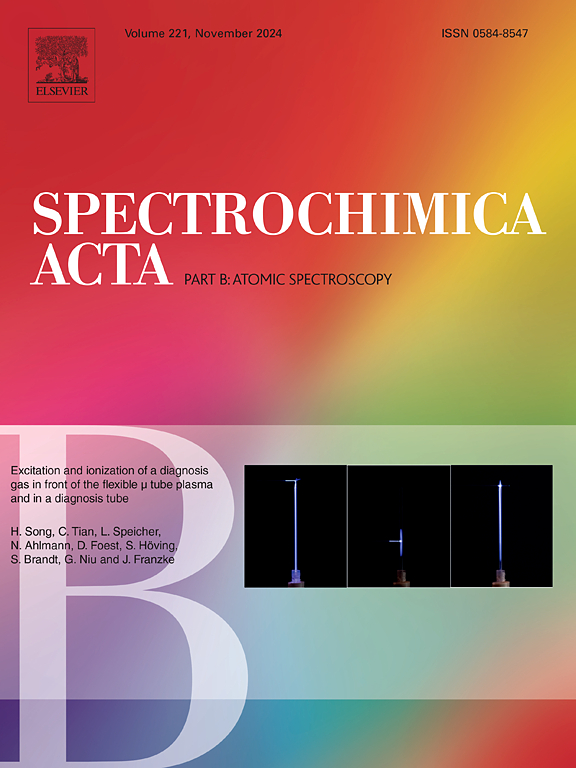Study on ablation behavior and mechanism for accurate determination of rare earth elements in CaF2 crystals by UV-LA-ICP-MS
IF 3.2
2区 化学
Q1 SPECTROSCOPY
引用次数: 0
Abstract
Catastrophic ablation of CaF2 crystals is often observed in ultraviolet-laser ablation-inductively coupled plasma-mass spectrometry (UV-LA-ICP-MS) analysis, leading to variations in the volume of ablated material and resulting analytical errors in LA-ICP-MS microanalysis. Therefore, it is essential to understand the ablation behavior and the interaction mechanisms between the laser and CaF2 crystals. In this study, we examined the effects of crystal surface roughness and laser fluence on ablation behavior. The CaF2 crystal polished with 1500 mesh abrasive paper exhibited a stable signal profile, a regular ablation crater, and the formation of nanoparticles, which align with predictions from the thermo-mechanical coupling model. Both higher and lower roughness resulted in either unstable ablation or uncontrolled ejection of fragments; the latter occurred when the thermal stress from accumulated light energy significantly exceeded the compressive strength of CaF2. Consequently, a roughness of 1500 mesh at the bottom of the ablation craters was deduced. We also identified a laser fluence of 14 J·cm−2 as the threshold for effective LA-ICP-MS analysis of CaF2 crystals, based on consistent signal profiles, elemental fractionation index (EFI), and crater morphology as revealed by LA-ICP-MS and scanning electron microscope (SEM) analyses, along with theoretical calculations from the thermo-mechanical coupling model. The optimal roughness (1500 mesh) and fluence (14 J·cm−2), together with the thermo-mechanical coupling model, can serve as guidelines for UV-LA-ICP-MS settings in further quantitative analyses of CaF2 crystals.

UV-LA-ICP-MS精确测定CaF2晶体中稀土元素的烧蚀行为及机理研究
在紫外激光烧蚀-电感耦合等离子体质谱(UV-LA-ICP-MS)分析中经常观察到CaF2晶体的灾难性烧蚀,导致烧蚀材料体积的变化,并导致LA-ICP-MS微分析中的分析误差。因此,了解激光与CaF2晶体之间的烧蚀行为和相互作用机制至关重要。在本研究中,我们考察了晶体表面粗糙度和激光辐照度对烧蚀行为的影响。用1500目砂纸抛光的CaF2晶体表现出稳定的信号分布、规则的烧蚀坑和纳米颗粒的形成,这与热-力耦合模型的预测一致。较高和较低的粗糙度都会导致不稳定的烧蚀或碎片不受控制的喷射;后者发生在积累光能产生的热应力显著超过CaF2的抗压强度时。由此推导出烧蚀坑底部的粗糙度为1500目。基于一致的信号谱、元素分析指数(EFI)、LA-ICP-MS和扫描电子显微镜(SEM)分析所揭示的陨石坑形态,以及热-力学耦合模型的理论计算,我们还确定了14 J·cm−2的激光通量作为有效的LA-ICP-MS分析CaF2晶体的阈值。最佳粗糙度(1500目)和通量(14 J·cm−2)以及热-力学耦合模型可作为进一步定量分析CaF2晶体的UV-LA-ICP-MS设置的指导。
本文章由计算机程序翻译,如有差异,请以英文原文为准。
求助全文
约1分钟内获得全文
求助全文
来源期刊
CiteScore
6.10
自引率
12.10%
发文量
173
审稿时长
81 days
期刊介绍:
Spectrochimica Acta Part B: Atomic Spectroscopy, is intended for the rapid publication of both original work and reviews in the following fields:
Atomic Emission (AES), Atomic Absorption (AAS) and Atomic Fluorescence (AFS) spectroscopy;
Mass Spectrometry (MS) for inorganic analysis covering Spark Source (SS-MS), Inductively Coupled Plasma (ICP-MS), Glow Discharge (GD-MS), and Secondary Ion Mass Spectrometry (SIMS).
Laser induced atomic spectroscopy for inorganic analysis, including non-linear optical laser spectroscopy, covering Laser Enhanced Ionization (LEI), Laser Induced Fluorescence (LIF), Resonance Ionization Spectroscopy (RIS) and Resonance Ionization Mass Spectrometry (RIMS); Laser Induced Breakdown Spectroscopy (LIBS); Cavity Ringdown Spectroscopy (CRDS), Laser Ablation Inductively Coupled Plasma Atomic Emission Spectroscopy (LA-ICP-AES) and Laser Ablation Inductively Coupled Plasma Mass Spectrometry (LA-ICP-MS).
X-ray spectrometry, X-ray Optics and Microanalysis, including X-ray fluorescence spectrometry (XRF) and related techniques, in particular Total-reflection X-ray Fluorescence Spectrometry (TXRF), and Synchrotron Radiation-excited Total reflection XRF (SR-TXRF).
Manuscripts dealing with (i) fundamentals, (ii) methodology development, (iii)instrumentation, and (iv) applications, can be submitted for publication.

 求助内容:
求助内容: 应助结果提醒方式:
应助结果提醒方式:


